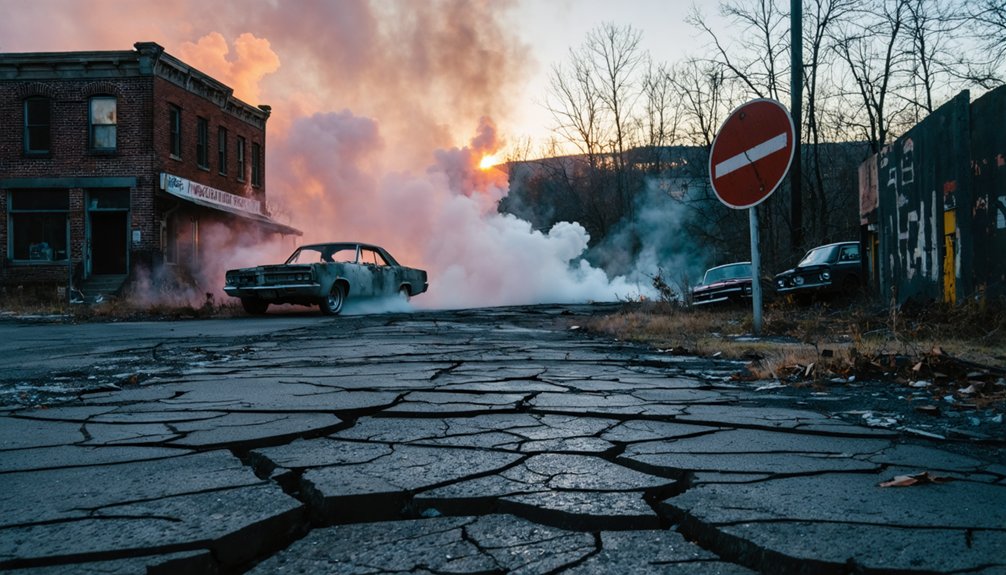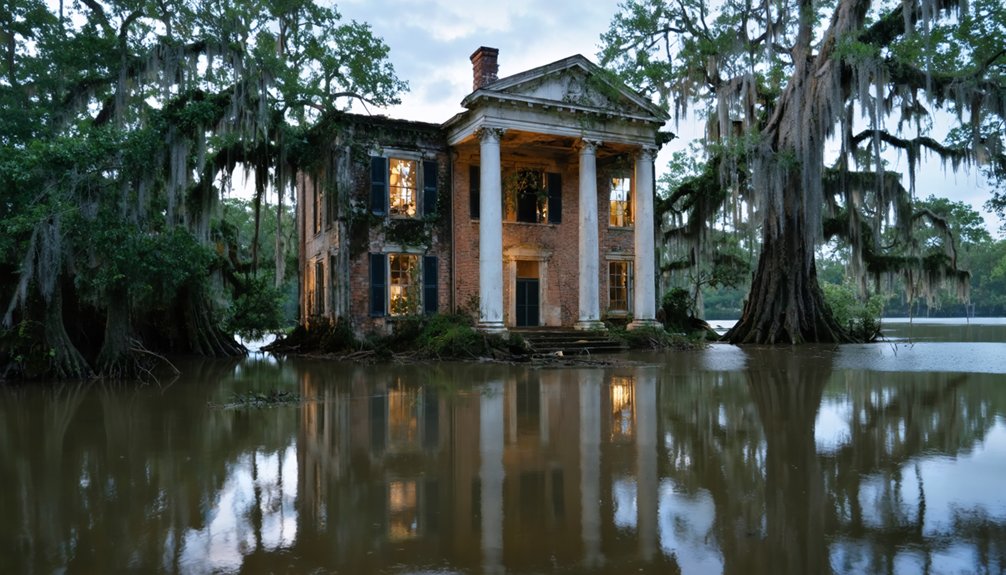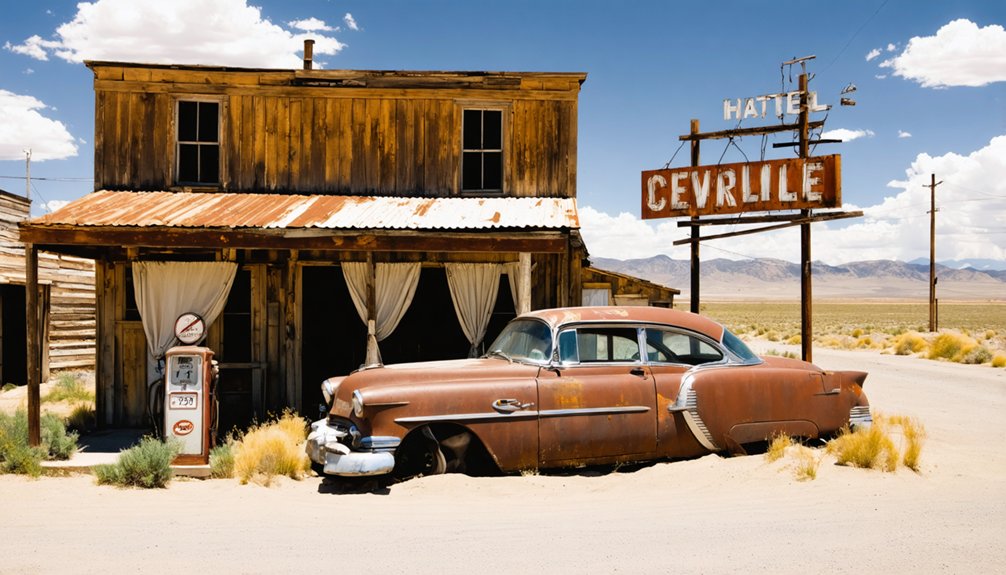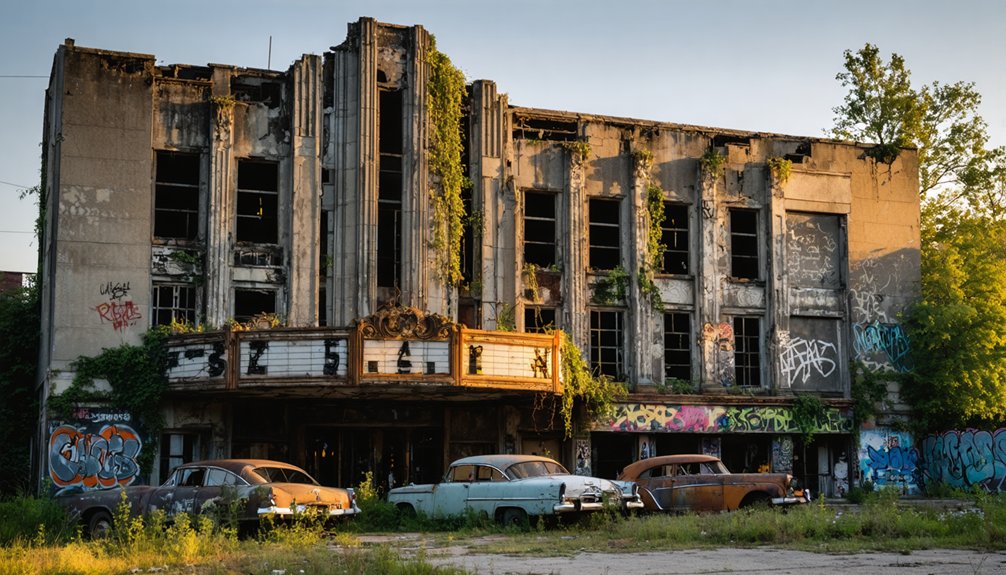America’s ghost towns offer glimpses into post-apocalyptic landscapes shaped by environmental disasters, economic collapse, and human abandonment. You’ll discover Centralia’s perpetual underground fire, Bodie’s pristinely preserved Wild West structures, and Rhyolite’s rapid boom-and-bust cycle. Some communities now lie submerged under reservoir waters, revealing themselves only during droughts. These haunting sites serve as time capsules of American history, where crumbling architecture and rusted remnants tell stories that modern settlements cannot.
Key Takeaways
- Centralia’s underground fire burns since 1962, creating a real-life post-apocalyptic landscape of toxic gases and abandoned structures.
- Bodie, California maintains over 100 original structures in “arrested decay,” offering an authentic glimpse into abandoned frontier life.
- Rhyolite’s rapid boom-and-bust cycle left impressive ruins including a bank and railway station in Nevada’s desert landscape.
- Drought conditions occasionally reveal submerged towns beneath reservoirs, exposing foundations, tombstones and remnants of daily life.
- Ghost towns provide unique photography opportunities, especially during golden hour when light enhances weathered wood and rusted metal textures.
The Burning Ground: Centralia’s Ongoing Apocalypse

Beneath the cracked streets of what was once a thriving Pennsylvania coal town, an apocalyptic fire has raged unchecked for over six decades, transforming Centralia into America’s most infamous ghost town.
The inferno began in May 1962 when burning trash in an abandoned strip mine ignited an exposed coal seam. Despite initial firefighting efforts with water and clay, the blaze spread through underground tunnels.
Beneath quiet Pennsylvania streets, an unstoppable inferno has silently raged since one fateful day in 1962.
Centralia’s history as a mining community, established in 1866 with nearly 3,000 residents, ended abruptly as toxic gases forced evacuations.
By 2020, only five stubborn residents remained in this least-populated Pennsylvania municipality. The government condemned homes and implemented buyout programs, demolishing most structures.
The toxic legacy continues today with unstable ground, carbon monoxide emissions, and sudden fissures. Engineering studies conducted in 1983 determined the fire could potentially spread across 3,700 acres of land before burning itself out.
In 2013, the remaining inhabitants reached a settlement with the government, receiving compensation and lifetime rights to their homes, although the properties would revert to the state upon their death or departure.
Scientists estimate this underground hell could burn for another century.
Frozen in Time: The Wild West Preservation of Bodie
You’ll encounter Bodie, California’s gold rush-era ghost town, preserved in what experts call “arrested decay,” where buildings stand exactly as they were left when the final residents departed.
The preservation approach maintains the town’s authentic abandoned state, with interiors still stocked with original goods and furniture, while preventing further deterioration without modernizing or restoring structures.
This meticulous preservation philosophy, combined with the desert climate’s natural preserving qualities, allows visitors to experience a genuine Wild West environment with over 100 remaining buildings including the Standard Stamp Mill, Methodist church, and residential homes containing original artifacts. As a disambiguation term, “Bodie” can also refer to other locations and individuals with this name. At its peak in 1879, Bodie was a bustling town with a population reaching nearly 10,000 residents and over 2,000 buildings.
Stalled Western Decay
While many ghost towns across America have succumbed to complete deterioration or commercial redevelopment, Bodie stands apart as a remarkable tribute to the West’s bygone era through its unique “arrested decay” preservation approach.
Since becoming a State Historic Park in 1962, California’s commitment to historical preservation has frozen Bodie in time. You’ll find approximately 110 structures still standing—including hotels, the jail, and Methodist church—exactly as they were when the last residents departed.
Peering through windows, you’ll glimpse interiors with original furnishings and goods, untouched by modern restoration efforts. The Bodie Foundation tackles the challenges of urban decay by conducting only essential repairs to prevent further deterioration.
This deliberate preservation strategy allows you to experience an authentic slice of Western history without the sanitized feel of typical tourist attractions. Visitors can gain deeper insight into Bodie’s past through daily public tours offered from late May to early September, providing a more immersive historical experience.
Desert’s Preserving Touch
Bodie’s exceptional preservation owes much to its unforgiving environment, which has paradoxically served as its greatest ally in defying time. Perched at 8,379 feet in California’s Sierra Nevada, the remote ghost town benefits from desert preservation conditions that naturally prevent decay.
Unlike other abandoned settlements, Bodie’s dry climate minimizes moisture damage while its isolation has deterred vandalism that plagued places like Aurora.
When you visit, you’ll witness “arrested decay” preservation—buildings maintained exactly as residents left them in the 1940s. The Bodie Foundation works alongside state agencies to stabilize structures without restoration, allowing the authentic abandoned history to remain intact. As a 501(c)(3) non-profit corporation, the Foundation is committed to maintaining the historical integrity of the site while enhancing visitor experience through educational programs.
This deliberate approach guarantees that when you walk Bodie’s streets, you’re experiencing genuine remnants of boom-and-bust America rather than reconstructed history.
Southern Ghosts: Cahawba’s Flooded Past and Haunting Ruins

Among the most compelling Southern ghost towns, Cahawba stands as a haunting symbol of nature’s dominance over human ambition.
You’re walking on ground that once hosted Alabama’s first capital, established in 1818 atop Native American settlements possibly dating to de Soto’s conquest. Despite its strategic river confluence location, Cahawba’s history was marked by persistent flooding and devastating yellow fever outbreaks.
As you tread upon Cahawba, you walk where Alabama’s first capital rose and fell, conquered by water and disease.
The town’s decline accelerated after the capital moved to Tuscaloosa in 1825. Though briefly revived as a cotton hub, the catastrophic 1865 flood sealed Cahawba’s fate. Planned with a grid layout similar to Philadelphia, the town featured streets named after trees.
Today, you’ll find only scattered ruins—the Crocheron Columns, Castle Morgan’s remains, and two cemeteries—where 3,000 residents once lived. During the Civil War, the site became infamous for Castle Morgan prison, where many Union soldiers were held captive before their tragic deaths aboard the exploding Sultana steamboat. Now preserved as an archaeological park, these flooded ruins whisper stories of economic ambition undone by environmental forces.
Desert Whispers: The Rapid Rise and Fall of Rhyolite
Nestled in the harsh Nevada desert, Rhyolite exemplifies the meteoric trajectory of Western boom-and-bust mining towns. Born in 1904 following gold discoveries by prospectors Harris and Cross, the settlement exploded from a tent city to a bustling community of 5,000 within three years.
You’ll find that Rhyolite’s fleeting prosperity manifested in luxuries unusual for mining camps: electricity, a substantial bank, railroads, and dozens of businesses. Charles M. Schwab’s significant investment in 1906 brought modern infrastructure development to the booming town.
The town boasted an impressive water system that efficiently supplied the growing population by mid-1905.
The Montgomery Shoshone Mine fueled these golden promises, producing over $1 million in precious metals.
Beneath the Surface: America’s Submerged Ghost Towns

While many ghost towns stand as weathered monuments on America’s landscape, a different category of abandoned settlements lies hidden beneath the nation’s waters—America’s submerged ghost towns.
You’ll find these underwater communities across the country, from Bluffton, Texas, to Loyston, Tennessee—sacrificed for progress as dams created reservoirs. During drought periods, these submerged histories resurface, revealing tombstones, foundations, and remnants of daily life frozen in time.
America’s drowned towns wait silently underwater, only revealing themselves when drought pulls back the liquid veil covering their forgotten stories.
The Quabbin Reservoir in Massachusetts covers entire towns, requiring the relocation of 2,500 residents and 7,000 graves.
Underwater archaeology has documented sites like Old Bluffton, where drought exposed a cotton gin, hotel, and bank. These communities—once thriving with schools, hotels, and train depots—now exist as preserved time capsules beneath lakes that serve millions with water and power.
Lost Mining Communities: From Boom to Abandoned
Wandering through America’s ghost towns, you’ll witness the dramatic transformation of once-thriving mining communities that exploded into existence following precious metal discoveries, only to collapse when resources depleted.
These boom-to-bust settlements, like Bodie, California with its 100+ structures maintained in “arrested decay,” offer authentic glimpses into frontier life where thousands once sought fortune amidst hastily constructed saloons, homes, and commercial buildings.
You’re experiencing living museums where economic opportunity once attracted diverse populations including immigrants and Native Americans, though many sites now harbor environmental hazards from abandoned mines that continue to impact surrounding communities.
Riches to Ruins
Throughout America’s vast landscape, hundreds of once-thriving mining communities stand frozen in time, testifying to the dramatic boom-and-bust cycle that defined American westward expansion.
You’ll find towns like Bodie, California, and Castle Dome, Arizona, where populations swelled to thousands following mineral discoveries, only to collapse when resources disappeared.
These economic shifts were typically devastating—places like Shenandoah, Pennsylvania saw population declines exceeding 80% as mines closed and unemployment soared.
The mining legacies left behind include not just vacant buildings but deadly environmental hazards: contaminated soil, toxic water supplies, and unstable structures.
Today, these towns exist in various states of preservation, from “arrested decay” historic parks to completely abandoned settlements.
While Texas claims the most ghost towns at 511, the American West holds the highest concentration of these silent monuments to resource extraction.
Preserved Wild West
The American Wild West preserves its mining heritage in spectacular fashion through dozens of well-maintained ghost towns that offer visitors authentic glimpses into frontier life.
You’ll discover meticulously preserved structures in places like Bodie, California, where 110 buildings stand frozen in time since its 1870s gold rush heyday.
Ghost town preservation efforts showcase mining communities that once flourished with thousands of residents before economic shifts and resource depletion forced abandonment.
At Calico, which produced $20 million in silver before markets collapsed in the 1890s, you’re free to wander through restored buildings that housed 500 mines.
Similarly, Kennecott’s copper mining legacy lives on through museum exhibits detailing its early 20th-century significance in America’s electrification.
These sites honor diverse community stories, from immigrant labor to African American settlements, all essential pieces of our national identity.
Photographing Decay: Capturing America’s Ghost Town Legacy

As America’s forgotten settlements surrender to the relentless forces of time, photographers have discovered extraordinary opportunities for visual storytelling among the crumbling facades and empty streets of ghost towns.
The decay aesthetics of locations like Bodie, California—with its over 100 preserved buildings in “arrested decay”—provide unparalleled backdrops for capturing historical narrative through your lens.
You’ll find wide-angle lenses essential for emphasizing the vast emptiness of these abandoned spaces, while golden hour lighting accentuates the textures of weathered wood and rusted metal.
Consider visiting Bannack, Montana, where timber structures tell nuanced stories of American frontier life.
When documenting these sites, remember your ethical responsibility—never disturb artifacts, secure proper permissions, and approach these fragile monuments with respect for their cultural significance.
Frequently Asked Questions
Are Ghost Towns Legally Accessible, or Is Entry Considered Trespassing?
Ghost towns’ accessibility depends on ownership status. You’ll face legal implications if entering privately-owned sites without permission, as trespassing laws still apply despite their abandoned appearance.
What Safety Precautions Should Visitors Take When Exploring Abandoned Towns?
You’re practically invincible until you’re not. Wear appropriate safety gear including sturdy boots, gloves, and respirators. Be vigilant for wildlife encounters—snakes and insects often claim abandoned structures as their sovereign territory.
Do Any Ghost Towns Have Permanent Residents or Caretakers?
Yes, some ghost towns maintain caretakers who perform preservation roles, while others house permanent residents with fascinating stories of resilience. You’ll encounter both when exploring these living historical remnants.
How Do Weather Conditions Affect Preservation of Ghost Town Structures?
Like hungry wolves, weather elements devour ghost towns. You’ll notice temperature fluctuations, humidity, precipitation, and winds constantly attacking structures. Without proper preservation techniques, these forces accelerate the inevitable return to dust.
Can Artifacts Be Collected From Ghost Towns as Souvenirs?
No, you can’t legally collect artifacts from ghost towns. Their preservation is essential for historical documentation, and ethical considerations demand respecting land ownership and cultural heritage protection laws governing these sites.
References
- https://carte-urbex.com/blogs/infos/top-10-abandoned-places-in-the-usa
- https://devblog.batchgeo.com/ghost-towns/
- https://albiongould.com/ghost-towns-to-visit-in-the-states/
- https://www.geotab.com/ghost-towns/
- https://www.united.com/en/us/hemispheres/places-to-go/5-western-ghost-towns.html
- https://www.timeout.com/usa/things-to-do/ghost-towns-usa
- https://www.youtube.com/watch?v=Z69cNeuZGsA
- https://en.wikipedia.org/wiki/Lists_of_ghost_towns_in_the_United_States
- https://www.atlasobscura.com/lists/americas-best-preserved-ghost-towns
- https://www.legendsofamerica.com/centralia-pennsylvania/



